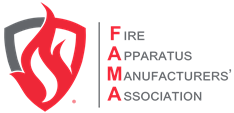The Fire Apparatus Manufacturers’ Association (FAMA) is committed to the manufacture and sale of safe, efficient fire apparatus and fire equipment. Its goal is to provide tools and information to promote fire apparatus safety. With that goal in mind, member companies have been learning about the need to better protect firefighters from exposure to contaminants picked up while working at the fire scene.
Cycle of Contamination
The Firefighter Cancer Support Network published a white paper titled, “Taking Action Against Cancer in the Fire Service.” It identified areas where firefighters were highly likely to be exposed to contaminants. The report cited that contaminated gear was often placed into the cabs after a fire, and the interior of the apparatus cab was rarely decontaminated. The contaminated particles will attach to their gear and transfer to the apparatus. Upon return to the station, contaminants will adhere to the walls and other equipment, resulting in off-gassing of contaminants. Exposure is not only a risk to the firefighter but to the public who may visit the fire station and family members if the contaminants are not completely removed before end of shift and the firefighter goes home.
Breaking the Cycle
The State of Washington department of Labor and Industries, Safety & Health Investment Projects, funded an initiative to establish a manual on the “Best Practice for Reducing Fire Fighter Risk of Exposures to Carcinogens.” The research was conducted in cooperation with the Washington State Council of Fire Fighters and the International Association of Fire Fighters.
They published the “Healthy In, Healthy Out” report that contains a list of best practices including a section devoted to apparatus design. Apparatus can be designed with careful thought given to biological and chemical contamination and the potential for cross contamination both inside the fire station and while on scene. The following is a synopsis of its recommendations:
- Avoid storing contaminated self-contained breathing apparatus in the cab.
- Use seat covering material that is easy to clean.
- Provide warm water for initial decontamination prior to re-entering the cab.
- Use cab flooring material that is easy to clean.
- Exhaust pipes should be designed to exit away from personnel*
- Cab interiors should be designed for easy cleaning.
- There should be a dedicated location for dirty turnout gear that is isolated from occupant space.
Diesel Engine Contaminants
In addition to reducing the risk of fireground contaminants, departments should consider steps to reduce exposure from diesel engine exhaust in living quarters of fire stations. The following steps can help:
- Employ a station design that maintains an air lock between the apparatus bay and the living quarters.
- Upgrade to apparatus with 2010 or newer diesel engines that include the latest Environmental Protection Agency certified clean diesel emissions technology.
- Use exhaust emissions extraction equipment.
- Use direct source vehicle mounted exhaust removal systems.
Future Apparatus Design
FAMA member companies are studying the results of the research and are active in offering design solutions that departments can specify on new apparatus that will satisfy these recommendations. They remain committed to supporting the industry as new research is released, and departments begin adopting alternative SOPs. They encourage departments to work with their apparatus manufacturers to specify apparatus in a way that supports healthy procedures that will benefit firefighters now and in the future.
FAMA is committed to the manufacture and sale of safe, efficient emergency response vehicles and equipment. FAMA urges fire departments to evaluate the full range of safety features offered by its member companies.
